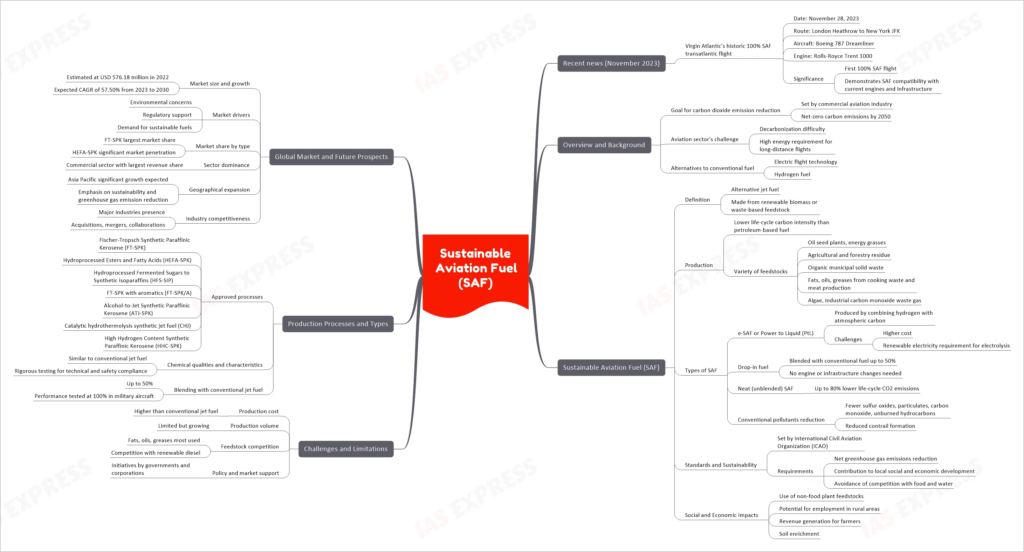Sustainable Aviation Fuel (SAF)
Introduction
In a significant leap towards sustainable aviation, November 2023 witnessed Virgin Atlantic’s historic transatlantic flight, powered entirely by Sustainable Aviation Fuel (SAF). This pioneering event, featuring a Boeing 787 Dreamliner flying from London Heathrow to New York JFK, represents a major milestone in the aviation industry’s journey towards decarbonization.
Overview and Background of SAF
Goal for Carbon Dioxide Emission Reduction
The commercial aviation industry, amidst recovering from COVID-19 impacts, has committed to achieving net-zero carbon emissions by 2050. This ambition reflects a growing recognition of the environmental footprint of air travel and an urgent need to address climate change.
Aviation Sector’s Challenge in Decarbonization
Aviation, with its high energy demands for long-distance flights, faces significant hurdles in reducing carbon emissions. While alternatives like electric flight technology and hydrogen fuel are evolving, their current limitations make immediate widespread adoption challenging.
Sustainable Aviation Fuel (SAF): A Comprehensive Approach
Definition and Production
SAF is a cleaner alternative to conventional jet fuel, derived from renewable biomass or waste-based feedstock. Its production results in lower life-cycle carbon intensity and utilizes a variety of feedstocks including plants, agricultural residues, and waste oils.
Types of SAF
There are various types of SAF, including e-SAF or Power to Liquid (PtL) fuels. These are produced by combining hydrogen with carbon extracted from the atmosphere, albeit with higher production costs and significant energy requirements for electrolysis.
Drop-in Fuel and Neat SAF
SAF is a “drop-in” fuel, blendable with conventional fuel up to 50%, requiring no modifications to existing aircraft engines or fueling infrastructure. Unblended SAF can significantly reduce life-cycle CO2 emissions by up to 80%.
Reduction in Conventional Pollutants
SAF emits fewer sulfur oxides, particulates, carbon monoxide, and unburned hydrocarbons. This not only improves local air quality around airports but also reduces the formation of contrails, which contribute to aviation’s climate impact.
Standards and Sustainability
The International Civil Aviation Organization (ICAO) has set standards for SAF to ensure net greenhouse gas emissions reduction and to contribute to local social and economic development.
Social and Economic Impacts
The production of SAF from non-food plant feedstocks offers potential benefits including job creation in rural areas, additional revenue for farmers, and soil enrichment.
Challenges and Limitations
Production Cost and Volume
Despite its environmental benefits, SAF currently costs significantly more than fossil-based fuel and is produced in limited volumes.
Feedstock Competition and Policy Support
The majority of SAF is produced from fats, oils, and greases, leading to competition with renewable diesel. The growth of the SAF industry is also contingent on supportive policies and market incentives.
Production Processes and Types
Approved Processes
There are seven internationally approved processes for SAF production, each with specific feedstock options and blending limits.
Chemical Qualities and Characteristics
SAF must maintain chemical qualities akin to conventional jet fuel, undergoing rigorous testing to ensure safety and technical compliance.
Blending with Conventional Jet Fuel
While currently blendable up to 50% with conventional jet fuel, advancements are paving the way for higher blend limits, with successful 100% usage in military aircraft.
Global Market and Future Prospects
Market Size and Growth
The global SAF market, valued at approximately USD 576.18 million in 2022, is projected to experience robust growth, driven by environmental concerns, regulatory support, and increasing demand for sustainable fuels.
Market Share by Type and Sector Dominance
Fischer-Tropsch Synthetic Paraffinic Kerosene (FT-SPK) and Hydroprocessed Esters and Fatty Acids (HEFA-SPK) are leading in market share. The commercial sector currently dominates the market, driven by regulatory demands and environmental concerns.
Geographical Expansion
The Asia Pacific region is expected to see significant growth due to a focus on sustainability and greenhouse gas emission reduction. This is further bolstered by the proliferation of low-cost airlines and infrastructure development in emerging economies.
Industry Competitiveness
The global SAF market is marked by intense competition among major industries, with key players engaging in strategic acquisitions, mergers, and collaborations.
Conclusion
The successful flight of Virgin Atlantic’s 100% SAF-powered Boeing 787 Dreamliner marks a pivotal moment in aviation’s quest for sustainability. SAF represents not just an alternative fuel but a comprehensive solution addressing the environmental impacts of air travel. While challenges in production cost and volume persist, the ongoing advancements, coupled with increasing market demand and supportive policies, signal a promising future for sustainable aviation.
If you like this post, please share your feedback in the comments section below so that we will upload more posts like this.


